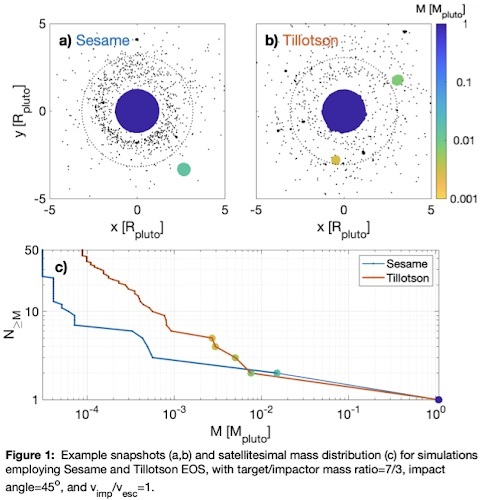Properties of Debris Disk and Satellitesimals in Pluto-Like Impacts Under Different Equations of State
- 1Weizmann Institute of Science, Rehovot, Israel
- 2Southwest Research Institute, Boulder, CO, USA
Introduction: A common outcome of a giant impact event is the formation of a circumplanetary debris disk, and in some cases, the capture of the surviving impactor, which results in a system composed of a primary, secondary, and a debris disk. The material in the debris disk may be accreted by the primary body (and secondary, if it exists), escape the system, or coalesce into larger clumps. A classic example of a system thought to originate by such an impact event is the Pluto-Charon binary system (Canup, 2005, 2011), in which all six bodies (including the other smaller satellites) lie approximately on the same plane and have nearly circular orbits.
Such impacts are simulated using smoothed particle hydrodynamics (SPH) codes including self gravity. The equation of state (EOS) governs the relationship among the thermodynamic variables of the simulated material. The specific EOS used in the simulation may influence the final post-impact structure. In order to quantify the typical differences, we compare two approaches, one simple analytic and one tabulated EOS. Tillotson (Tillotson, 1962) is a widely used analytic EOS and is computationally fast, but it lacks important details such as the treatment of phase changes. Sesame (Bennett et al., 1978) is a commonly used tabulated EOS and is more accurate, but is computationally slower and may be poorly sampled in the required thermodynamic phase-space. Here we show a set of SPH impact simulations that assume similar geometric and dynamic initial conditions but different EOS.
Methods: We performed ~100 SPH simulations using SWIFT code (Schaller et al., 2018), simulating Pluto-like impacts with 105-106 particles. The initial bodies are assumed to be differentiated, with target to impactor mass ratio of 1 or 7/3, impact angle, ξ, of 0, 30, 45, 60°. Impact velocity was chosen to be relatively small, 1-1.1 times the escape velocity. The impactor was either spin-less or rotating with a period of 5 or 10 hours. This parameter space was motivated by previous simulations (Canup, 2011) for the formation of the Pluto-Charon system. We compare results using the Tillotson and Sesame EOS. The simulations were stopped after 4 days, the typical time for the central body to relax to a stable spherical shape. We developed an algorithm to detect post-impact clumps. Two particles were considered in contact if their mutual distance was smaller than their combined smoothing lengths. The orbital elements of each clump (“satellitesimal”, defined as 100 particles in pairwise contact, equivalent to ~10-3Mpluto) were computed and studied.
Results: Disk systems were formed for impact angles >30°, in using both EOSs. Satellitesimals, when formed, showed different properties. Figure 1 panels (a,b) show the final snapshots of an impact that produced a debris disk and several satellitesimals highlighted in color corresponding to their masses. In this example, a more massive debris disk with a larger number of satellitesimals is obtained when using Tillotson EOS than using Sesame. Moreover, in addition to the target body, at least one large satellitesimal was formed in each of the simulations, but their composition, mass, and orbital elements differ between the EOSs. In comparing the Sesame run to Tillotson, the largest satellitesimal has a mass of 0.015Mpluto (with water fraction of 0.16) and 0.008Mpluto (with water fraction of 0.30) respectively. Its orbital elements are e=0.67, a=10.07Rpluto for Sesame runs, and e=0.15, a=3.2Rpluto for Tillotson. At smaller masses, using Tillotson EOS produces a greater number of clumps, as seen in Figure 1c. Three more satellitesimals were formed (some beyond the plot limits of 1b), with e=0.86, 1.35, 0.10. Note that the satellitesimal mass is an order of magnitude smaller than Charon, so alone they do not predict Charon’s formation (Canup, 2011).
In the final snapshot, a greater fraction of debris disk particles lie within the Roche limit (computed using present-day Charon’s density (McKinnon et al., 2017)) in the Sesame simulation, whereas the Tillotson disk extends to a greater distance. In terms of mass, angular momentum, and composition, the debris disks are similar (0.025 versus 0.033 of the total mass; 0.19 versus 0.25 of the total angular momentum; water fraction of 0.44 versus 0.37 for Sesame and Tillotson respectively). We note the execution time was 2-3 times longer for the simulations using Sesame than Tillotson, a factor which may be considered in choosing EOS.
Exploring the parameter space, we note that head-on impacts (ξ~0°) produce a merged single body, with the vast majority of ejected particles accreted by the planet, and the rest ejected to space. Oblique, faster than escape velocity impacts (vimp/vesc=1.1 and ξ=60°) resulted in two unbound bodies, with little mass transfer between the two, consistent with previous studies of planetary impacts (Leinhardt & Stewart, 2012).

References:
Bennett, B. I., Johnson, J. D., Kerley, G. I., & Rood, G. T. (1978). Recent developments in the Sesame equation-of-state library. https://doi.org/10.2172/5150206
Canup, R. M. (2005). A Giant Impact Origin of Pluto-Charon. Science, 307(5709), 546–550.
Canup, R. M. (2011). On a Giant Impact Origin of Charon, Nix, and Hydra. The Astronomical Journal, 141(2), 35.
Leinhardt, Z. M., & Stewart, S. T. (2012). Collisions Between Gravity-Dominated Bodies. I. Outcome Regimes and Scaling Laws. The Astrophysical Journal, 745(1), 79.
McKinnon, W. B., Stern, S. A., Weaver, H. A., Nimmo, F., Bierson, C. J., Grundy, W. M., et al. (2017). Origin of the Pluto–Charon system: Constraints from the New Horizons flyby. Icarus. https://doi.org/10.1016/j.icarus.2016.11.019
Schaller, M., Gonnet, P., Chalk, A. B. G., & Draper, P. W. (2018, May 1). SWIFT: SPH With Inter-dependent Fine-grained Tasking. Astrophysics Source Code Library. Retrieved from https://ui.adsabs.harvard.edu/abs/2018ascl.soft05020S
Tillotson, J. H. (1962). Metallic equations of state for hypervelocity impact (No. Rep. GA-3216 ). General Dynamics San Diego CA.
How to cite: Shimoni, Y., Aharonson, O., and Rufu, R.: Properties of Debris Disk and Satellitesimals in Pluto-Like Impacts Under Different Equations of State, Europlanet Science Congress 2020, online, 21 September–9 Oct 2020, EPSC2020-1033, https://doi.org/10.5194/epsc2020-1033, 2020

